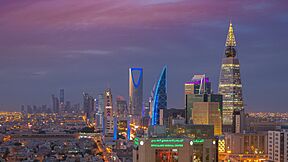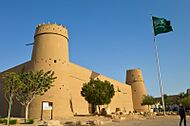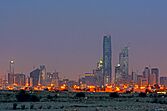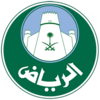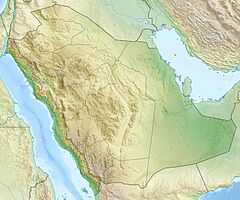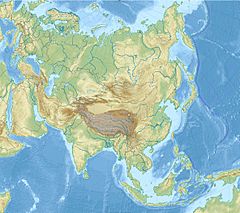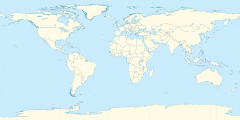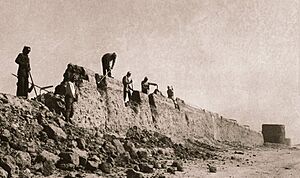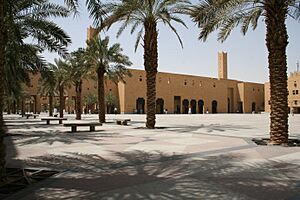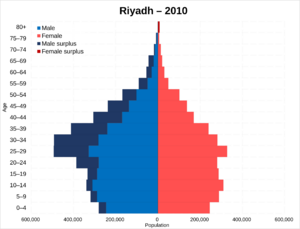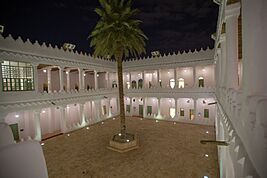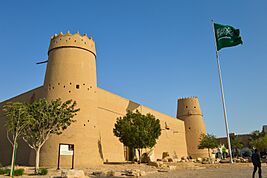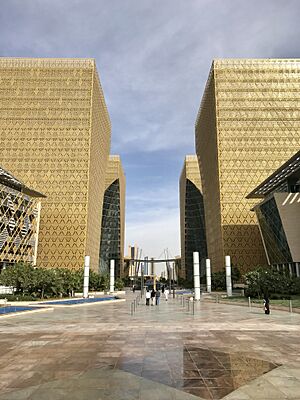Riyadh facts for kids
Quick facts for kids
Riyadh
الرياض
|
||
|---|---|---|
|
|
||
|
||
| Country | ||
| Province | Riyadh Province | |
| Governorate | Riyadh Governorate | |
| Established | 1746 | |
| Founded by | Dahham ibn Dawwas | |
| Government | ||
| • Body | Riyadh Municipality | |
| Area | ||
| • Capital city | 1,973 km2 (762 sq mi) | |
| Elevation | 612 m (2,008 ft) | |
| Population
(2022)
|
||
| • Capital city | 7,009,100 | |
| • Density | 3,552.5/km2 (9,201.0/sq mi) | |
| • Metro | 7,820,551 | |
| GDP (PPP, constant 2015 values) | ||
| • Year | 2023 | |
| • Total | $428.7 billion | |
| • Per capita | $55,800 | |
| Time zone | UTC+03:00 (AST) | |
| Postal Code |
(5 digits)
|
|
| Area code(s) | +966 011 | |
| HDI (2021) | 0.900 – very high | |
Riyadh (pronounced ree-YAHD) is the capital and largest city of Saudi Arabia. It is also the main city of the Riyadh Province and the Riyadh Governorate. The name Riyadh means "the Meadows," referring to the green areas it once had. The city grew a lot after its old walls were taken down in the 1950s.
Riyadh is the biggest city on the Arabian Peninsula. It is located in the middle of the an-Nafud desert, on the eastern part of the Najd plateau. The city is about 600 meters (about 2,000 feet) above sea level. Around 5 million tourists visit Riyadh each year. In 2022, Riyadh had a population of 7 million people. This makes it the most populated city in Saudi Arabia.
The city was first called Riyadh in 1590. In 1745, Dahham ibn Dawwas took control of the town. He built a mud-brick palace and a wall around it. Later, in 1744, Muhammad ibn Abd al-Wahhab and Muhammad bin Saud took over Riyadh. Their state, the Emirate of Diriyah, fell in 1818. Then, Turki ibn Abdullah founded the Emirate of Nejd and made Riyadh its capital in 1825. In the early 1900s, 'Abdulaziz ibn Saud took back his family's kingdom. He named it Saudi Arabia in 1932, with Riyadh as the capital.
Riyadh is the main political and administrative center of Saudi Arabia. Important government groups like the Shura Council and the Council of Ministers are located here. Many foreign embassies are also in the city's Diplomatic Quarter.
The city is also very important for the economy. Many banks and big companies have their main offices in Riyadh. Highway 65, also known as King Fahd Road, goes through major business areas. These include the King Abdullah Financial District, which is one of the largest financial centers in the world. Riyadh is one of the fastest-growing cities in terms of population.
Riyadh is divided into 15 city areas. The Riyadh Municipality and the Royal Commission for Riyadh manage these areas. Riyadh will host Expo 2030, a big international event.
Contents
History of Riyadh
Early Beginnings
Long ago, before Islam, the area where Riyadh is now was called Hajr. It was founded by the Banu Hanifa tribe. Hajr was the capital of a region called Al-Yamamah. Over time, Hajr became smaller. In the 14th century, a traveler named Ibn Battuta visited Hajr. He described it as a city with canals and trees.
Later, Hajr split into smaller towns. Two important ones were Migrin and Mi'kal. The name Riyadh was first used in the 17th century. In 1737, a man named Deham ibn Dawwas took control of Riyadh. He built a wall around the different oasis towns, making them one strong city. The name "Riyadh" means "gardens," referring to these green oasis towns.
What Riyadh Produced
Riyadh, the capital of Saudi Arabia, was first known for its water and good land. This made it perfect for growing dates and other crops. Dates are very common in the Middle East. Wheat was also a big crop.
As the city grew, especially in the mid-1900s, what it produced changed. Now, almost one-third of Saudi Arabia's factories are in Riyadh. They make many things, like machines, metal goods, chemicals, and building materials. They also produce food, clothes, and furniture. So, Riyadh now focuses more on products for city life.
The Saudi States
In 1750, Muhammad ibn Abd al-Wahhab and Muhammad ibn Saud, the ruler of Diriyah, formed an alliance. Ibn Saud wanted to unite the region under one Islamic state. Riyadh resisted for a long time but finally joined the Saudis in 1774. This led to the creation of the First Saudi State, with Diriyah as its capital.
The First Saudi State was later destroyed in 1818. But in 1823, Turki bin Abdullah bin Muhammad started the Second Saudi State. He chose Riyadh as the new capital. After some struggles, the House of Saud became strong again.
However, rival groups caused the Second Saudi State to fall in 1891. The al-Masmak fort was built around this time. Later, in 1902, 'Abdul Aziz took back his family's kingdom. He expanded it to cover most of the Arabian Peninsula. In September 1932, he named his kingdom Saudi Arabia, and Riyadh became the capital.
Modern Growth
From the 1940s, Riyadh grew very quickly. When King Saud became king, he wanted to make Riyadh modern. He started building new areas in 1950. The city began to be built with a grid pattern of streets in 1953. The population grew by about 8% each year between 1974 and 1992.
King Khalid International Airport opened in 1983. It is one of the largest airports in the world.
In 2010, Diriyah, an old Saudi capital near Riyadh, became a World Heritage Site by UNESCO.
Today, Riyadh is a major center for business and government. Many large companies have offices here. The city also has the world's largest all-female university, the Princess Nora bint Abdul Rahman University.
How Riyadh Grew: A City's Journey
Early Days (Up to 1930s)
Old Riyadh was surrounded by walls. Inside, there was a town square and a market. Houses were made of mud-brick and had courtyards. Outside the walls were date palm orchards, which is why it was called ‘Riyadh’ (gardens). In the 1930s, the city started to expand. New government buildings were needed, and more people were moving in.
Oil Boom Years (1940s - 1950s)
When Saudi Arabia started producing oil, Riyadh changed fast. It went from traditional homes to newer buildings. A railway station and the first airport were built. Government offices moved from Jeddah to Riyadh. New housing areas, like Malaz, were built for government workers. These new areas, with their street grids and separate houses, helped shape how Riyadh would grow.
Planning for the Future (1960s - 1970s)
In 1968, experts were hired to create a master plan for Riyadh. They suggested that Riyadh should grow along a main commercial road. They also planned for the city to be divided into large blocks, making the grid pattern a key feature. This plan also kept the style of detached houses. However, the planners did not expect Riyadh to grow as fast as it did.
By the end of the 1970s, Riyadh had expanded far beyond its original size. In 1974, the Royal Commission for Riyadh City was created to manage the city's development. New roads, electricity, and water systems were built, allowing the city to grow even more.
Building the City's Look (1980s - 1990s)
Riyadh grew much faster than expected, so the city plan had to be updated in 1982. The new plan allowed the city to expand in all directions and added ring roads.
During the 1980s and 1990s, many famous buildings were constructed. These included the King Khalid International Airport, King Fahd Stadium, and the Television Tower. The historical area was also rebuilt with places like the National Museum and the Imam Turki bin Abdullah Mosque. Shopping centers and supermarkets also started to open.
Modern Times (2000s - 2010s)
From the 2000s, a new plan called MEDSTAR guided Riyadh's growth. This plan focused on making Riyadh a city with many important centers, not just one downtown. This led to areas like Olaya and KAFD becoming new hubs.
Riyadh's skyline grew with tall buildings along King Fahd Road. Big projects like the Riyadh metro and the Princess Nourah Bint Abdul Rahman University were built. Malls became popular, and parks were added to many neighborhoods. Major roads were also updated, changing the city's look.
Riyadh Today (2020 - Present)
Saudi Arabia's Vision 2030 aims to make its cities among the top 100 in the world for quality of life. Riyadh is working towards this goal with new projects. The city is seeing more tourists each year.
A huge urban park, King Salman Park, is being built where the old airport used to be. It will have places for fun, homes, offices, and shops. The historic city of Diriyah is also being restored as a cultural and tourist spot. New residential areas are being built in the far north and east of the city.
Geography and Climate
Riyadh's Weather
Riyadh has a hot desert climate. Summers are very long and extremely hot. The average high temperature in July is about 44 degrees Celsius (111 degrees Fahrenheit). Winters are short and very mild.
The city gets very little rain, especially in summer. Most rain falls in March and April. Riyadh can also have dust storms. Sometimes, the dust is so thick that it's hard to see. In April 2015, a huge dust storm hit Riyadh, causing schools to close and many flights to be canceled.
| Climate data for Riyadh (1991-2020) | |||||||||||||
|---|---|---|---|---|---|---|---|---|---|---|---|---|---|
| Month | Jan | Feb | Mar | Apr | May | Jun | Jul | Aug | Sep | Oct | Nov | Dec | Year |
| Record high °C (°F) | 33.0 (91.4) |
35.0 (95.0) |
38.0 (100.4) |
42.0 (107.6) |
46.0 (114.8) |
47.5 (117.5) |
48.4 (119.1) |
49.8 (121.6) |
46.8 (116.2) |
42.5 (108.5) |
38.0 (100.4) |
32.7 (90.9) |
49.8 (121.6) |
| Mean daily maximum °C (°F) | 20.7 (69.3) |
23.7 (74.7) |
28.0 (82.4) |
33.6 (92.5) |
39.5 (103.1) |
42.8 (109.0) |
43.9 (111.0) |
43.8 (110.8) |
40.9 (105.6) |
35.5 (95.9) |
27.4 (81.3) |
22.3 (72.1) |
33.5 (92.3) |
| Daily mean °C (°F) | 14.0 (57.2) |
16.7 (62.1) |
21.0 (69.8) |
26.4 (79.5) |
32.2 (90.0) |
35.2 (95.4) |
36.3 (97.3) |
36.0 (96.8) |
32.8 (91.0) |
27.5 (81.5) |
20.4 (68.7) |
15.4 (59.7) |
26.2 (79.1) |
| Mean daily minimum °C (°F) | 7.6 (45.7) |
9.9 (49.8) |
13.8 (56.8) |
19.1 (66.4) |
24.1 (75.4) |
26.1 (79.0) |
27.3 (81.1) |
27.0 (80.6) |
23.7 (74.7) |
18.9 (66.0) |
13.6 (56.5) |
9.1 (48.4) |
18.3 (65.0) |
| Record low °C (°F) | −5.4 (22.3) |
−3.3 (26.1) |
2.1 (35.8) |
8.9 (48.0) |
14.0 (57.2) |
19.8 (67.6) |
20.0 (68.0) |
20.0 (68.0) |
14.4 (57.9) |
8.9 (48.0) |
4.5 (40.1) |
−2.0 (28.4) |
−5.4 (22.3) |
| Average precipitation mm (inches) | 14.8 (0.58) |
8.3 (0.33) |
19.9 (0.78) |
23.7 (0.93) |
5.7 (0.22) |
0.0 (0.0) |
0.0 (0.0) |
0.0 (0.0) |
0.0 (0.0) |
1.5 (0.06) |
20.1 (0.79) |
13.5 (0.53) |
107.6 (4.24) |
| Average precipitation days (≥ 1.0 mm) | 1.7 | 1.5 | 2.6 | 3.7 | 0.9 | 0.0 | 0.0 | 0.0 | 0.0 | 0.4 | 2.5 | 1.7 | 14.9 |
| Average relative humidity (%) | 47 | 36 | 32 | 28 | 17 | 11 | 10 | 12 | 14 | 20 | 36 | 45 | 26 |
| Average dew point °C (°F) | 2 (36) |
1 (34) |
2 (36) |
4 (39) |
3 (37) |
−1 (30) |
0 (32) |
2 (36) |
2 (36) |
2 (36) |
4 (39) |
3 (37) |
2 (36) |
| Mean monthly sunshine hours | 212.4 | 226.6 | 219.8 | 242.3 | 287.7 | 328.2 | 332.1 | 309.2 | 271.6 | 311.4 | 269.2 | 214.3 | 3,224.8 |
| Percent possible sunshine | 63 | 71 | 59 | 63 | 70 | 80 | 80 | 77 | 74 | 87 | 82 | 65 | 72 |
| Average ultraviolet index | 3 | 7 | 9 | 11 | 12 | 13 | 13 | 12 | 11 | 8 | 6 | 3 | 9 |
| Source 1: NOAA, Jeddah Regional Climate Center | |||||||||||||
| Source 2: Time and Date (dewpoints, 1985-2015) | |||||||||||||
City Areas
Riyadh is divided into 14 main areas, plus the Diplomatic Quarter. Each area has many smaller districts, totaling over 130. The Olaya District is the main business area. It has places to stay, entertainment, restaurants, and shops. The Kingdom Centre, Al Faisalyah, and Al-Tahlya Street are famous landmarks there. The very old part of the city is called Al-Bathaa and Al-Deerah.
Some of the main districts in Riyadh include:
- Al-Bat'ha
- Al-Deerah (old Riyadh)
- Mi'kal
- Manfuha
- Manfuha Al-Jadidah
- Al-'Oud
- Al-Mansorah
- Al-Margab
- Salam
- Jabrah
- Al-Yamamah
- 'Otayyigah
- Al-'Olayya & Sulaymaniyyah
- Al-'Olayya
- Al-Sulaymaniyyah
- Al Izdihar
- King Fahd District
- Al-Masif
- Al-Murooj
- Al-Mugharrazat
- Al-Wurood
- Nemar
- Nemar
- Dharat Nemar
- Tuwaiq
- Hazm
- Deerab
- Irqah
- Irqah
- Al-Khozama
- Diplomatic Quarter
- Al-Shemaysi
- Al-Shemaysi
- Eleyshah
- Al-Badi'ah
- Syah
- Al-Nasriyyah
- Umm Sleym
- Al-Ma'athar
- Umm Al-Hamam (East)
- Al-Ma'athar
- Al-Olayya
- Al-Nakheel
- King Saud University main campus
- Umm Al-Hamam (East)
- Umm Al-Hamam (West)
- Al-Ma'athar Al-Shimali
- Al-Rahmaniyya
- Al-Muhammadiyya
- Al-Ra'id
- Al-Ha'ir
- Al-Ha'ir
- Al-Ghannamiyyah
- Uraydh
- Al-'Aziziyyah
- Al Aziziyah (Riyadh)
- Ad Dar Al Baida
- Taybah
- Al Mansouriyah
- Al-Malaz
- Al-Malaz
- Al-Rabwah
- Al-Rayyan
- Jarir
- Al-Murabba'
- Sinaiyah Qadeem
- Al-Shifa
- Al-Masani'
- Al-Shifa
- Al-Mansuriyya
- Al-Marwah
- Al-Urayja
- Al-Urayja
- Al-Urayja Al-Wusta
- Al-Urayja (West)
- Shubra
- Dharat Laban
- Hijrat Laban
- As-Suwaidi
- As-Suwaidi (West)
- Dahrat Al-Badi'ah
- Sultanah
- Al-Shemal
- Al-Malga
- Al-Sahafa
- Hittin
- Al-Wadi
- Al-Ghadir
- Al-Nafil
- Imam Muhammad ibn Saud University main campus
- Al-Qayrawan
- Al-Aqiq
- Al-Arid
- Al-Naseem
- Al-Naseem (East)
- Al-Naseem (West)
- As-Salam
- Al-Manar
- Al-Rimayah
- Al-Nadheem
- Al-Rawdhah
- Al-Rawdhah
- Al-Qadisiyah
- Al-M'aizliyyah
- Al-Nahdhah
- Gharnatah (Granada)
- Qortubah (Cordoba)
- Al-Andalus (Andalusia)
- Al-Hamra
- Al-Qouds
- Al-Selayy
- Al-Selayy
- Ad Difa'
- Al Iskan
- Khashm Al-'Aan
- Al-Sa'adah
- Al-Fayha
- Al-Manakh
- King Abdullah Financial District
- Diriyah (suburb of Riyadh)
Population of Riyadh
| Historical population | ||
|---|---|---|
| Year | Pop. | ±% p.a. |
| 1918 | 18,000 | — |
| 1924 | 30,000 | +8.89% |
| 1944 | 50,000 | +2.59% |
| 1952 | 80,000 | +6.05% |
| 1960 | 150,000 | +8.17% |
| 1972 | 500,000 | +10.55% |
| 1978 | 760,000 | +7.23% |
| 1987 | 1,389,000 | +6.93% |
| 1992 | 3,834,986 | +22.52% |
| 1997 | 3,100,000 | −4.17% |
| 2004 | 4,138,329 | +4.21% |
| 2009 | 4,873,723 | +3.33% |
| 2010 | 6,792,776 | +39.38% |
| 2013 | 5,899,528 | −4.59% |
| 2016 | 6,506,700 | +3.32% |
| 2017 | 7,676,654 | +17.98% |
| Source: Census data | ||
In 2022, Riyadh had over 7 million people. The city has grown very fast. In the 1960s, it had only 150,000 people. This huge growth is due to high birth rates and a strong economy. Many people from other countries have also moved to Riyadh. As of 2017, about 64% of the people in Riyadh are Saudis. The rest are from other countries, with the largest groups being from India and Pakistan.
Famous Buildings and Places
Old Riyadh Buildings
The old city of Riyadh was quite small, about 1 square kilometer. So, not many original buildings from that time are left. The most famous one is the Masmak fort. Some parts of the old city wall have also been rebuilt. There are a few old mud-brick houses, but most are in ruins.
The first big building outside the old walls was King Abdulaziz's Murabba Palace. It was built in 1936 and finished in 1938. This palace is now part of the King Abdul Aziz Historical Centre.
There are also old villages and towns near Riyadh that the city has now grown to include. These include Diriyah and Manfuha. Today, people appreciate traditional buildings more. The Saudi Commission for Tourism and National Heritage is working to save and restore these old buildings.
- Ain Heet Cave
Ain Heet cave has an underground lake that is 150 meters deep. It is located in a small village called Heet, near Mount Al Jubayl. This cave is easy to reach from Riyadh.
Historical Sites
Riyadh has several important historical sites. These include the five old gates of Riyadh's former walls. They are the eastern gate of Thumaira, the northern gate of Al-Suwailen, the southern gate of Dukhna, the western gate of Al-Madhbah, and the south-western gate of Shumaisi.
There are also four historic palaces: Musmak Palace, Murabba Palace (King Abdul Aziz's palace), Atiqah Palace, and Al Shamsiah Palace.
Turaif District
The Turaif district is another important historical site. It was added to the UNESCO World Heritage List in 2010. It was built in the 15th century in the Najdi architectural style. Some historic palaces and monuments in Al-Turaif district include Salwa Palace, Saad bin Saud Palace, and Imam Mohammad bin Saud Mosque.
Masmak Fortress
This fortress was built around 1865. In January 1902, Ibn Saud captured the Masmak fortress. This event was very important because it brought Riyadh back under Saudi control. The story of this capture is a famous part of Saudi history. Today, the Masmak Fortress is a museum.
Modern Buildings
Kingdom Centre
The Kingdom Centre is a very tall tower in Riyadh. It is 300 meters (about 984 feet) high and has 99 stories. It was designed by Ellerbe Becket and Omrania. The tower is owned by Kingdom Holding Company. It won an award in 2002 for its design.
The Kingdom Centre has a three-level shopping mall. The top part of the tower is split into two sections, connected by a sky-bridge walkway. This bridge offers amazing views of Riyadh. The shopping center even has a special floor just for women.
Burj Rafal Hotel Kempinski
Burj Rafal is the tallest skyscraper in Riyadh, standing at 307.9 meters (1,010 feet). It was built between 2010 and 2014. The tower has 474 apartments and a 5-star Kempinski hotel with 349 rooms.
Burj Al Faisaliyah
Al Faisaliyah Center was the first skyscraper built in Saudi Arabia. It is the third tallest building in Riyadh. The golden ball at the top of the tower looks like a ballpoint pen and holds a restaurant. Below it, there is a viewing deck. The building also has a shopping center with famous brands and a hotel. Al Faisaliyah Tower has 44 stories.
Riyadh TV Tower

The Riyadh TV Tower is 170 meters (about 558 feet) tall. It was built between 1978 and 1981. It is used for television broadcasts. Saudi TV channels broadcast from here, mainly in Arabic. Some radio shows are in English or French.
Museums and Collections
In 1999, the National Museum of Saudi Arabia opened in Riyadh. It brought together many important collections that were spread out before. For example, a meteorite fragment called the "Camel's Hump" is now on display there.
The Royal Saudi Air Force Museum, also known as Saqr Al-Jazira, is located on the East Ring Road. It has a collection of airplanes and other items used by the Royal Saudi Air Force and Saudia (Saudi Arabian Airlines).
Sports in Riyadh
Football is the most popular sport in Saudi Arabia. Riyadh has four major football clubs:
- Al Hilal: Established in 1957, they have won 18 championships in the Saudi Professional League.
- Al-Nassr: Established in 1955, they have won the Saudi Professional League 9 times.
- Al-Shabab: Established in 1947, they hold 6 championships.
- Al-Riyadh Club: Established in 1954.
The city also has several large stadiums. The King Fahd International Stadium can hold 70,000 people. It has hosted the FIFA Confederations Cup three times. The Prince Faisal bin Fahd Stadium can hold 22,500 people and is mostly used for football matches.
Riyadh hosted the 1997 Asian Basketball Championship.
In 2020, the world's richest horse race, the Saudi Cup, took place at the King Abdulaziz Racetrack in Riyadh. It offers a huge prize of US$20 million. Riyadh will also host the 2034 Asian Games.
Esports (electronic sports) are also growing in Riyadh. The city held its first major tournament in 2018. The Saudi Esports Federation organizes the Gamers8 festival, which in 2023 offered the largest prize pool in esports history at $45 million. This festival will be replaced by the Esports World Cup in 2024, with an even larger prize pool of over $60 million.
Getting Around Riyadh
By Air
Riyadh's main airport is King Khalid International Airport (KKIA). It is about 35 kilometers (22 miles) north of the city center. In 2013, over 20 million passengers used the airport. The airport is being expanded to become a huge airport, with plans to serve 120 million passengers per year by 2030.
By Bus
Riyadh has a bus rapid transit (BRT) network that is 85 kilometers (53 miles) long. The main bus company, SAPTCO, offers trips within Saudi Arabia and to nearby countries.
By Metro
The six-line Riyadh Metro system opened in 2024.
By Train
The Saudi Railways Organization runs passenger and cargo trains between Riyadh and Dammam. There are also plans for new railway lines connecting Riyadh to Jeddah and Mecca, and to northern Saudi Arabia.
By Road
Riyadh has a large highway system. The Eastern Ring Road connects the south and north of the city. The Northern Ring Road connects the east and west. King Fahd Road runs through the city center from north to south. Makkah Road goes east-west and connects different parts of the city.
Media in Riyadh
The Riyadh TV Tower, which is 170 meters (558 feet) tall, was built between 1978 and 1981. National Saudi television channels broadcast from here, mostly in Arabic. Some radio shows are in English or French.
Riyadh has several Arabic newspapers, including Al Riyadh and Al Jazirah. There are also English newspapers like Saudi Gazette and Arab News. The Saudi government controls internet content.
New Projects and Development
In 2019, King Salman announced a plan to start 1281 development projects in Riyadh. This plan will cost around US$22 billion. The main goal is to improve Riyadh's roads, transportation, environment, and other facilities. As part of Saudi Vision 2030, the plan includes building new homes, a huge museum, sports areas, and medical and educational facilities.
The Vision 2030 aims to boost tourism and make Saudi Arabia a global leader. To make the city more artistic, 1000 pieces of art are planned to be displayed publicly by 2030. In 2020, Saudi Arabia set aside $20 billion for a big tourism and culture project in Diriyah.
In 2021, the SEK International School Riyadh opened, offering the International Baccalaureate program. In 2024, a plan was approved to create the Sports Boulevard, which will include the world's tallest sports tower. This is part of a $23 billion project to add more green spaces in the city.
Arts and Culture
Arts can bring big changes to societies, and Riyadh is no different. Many Muslim scholars from Saudi Arabia have greatly improved arts and literature. The growth of farming is thought to have helped the arts grow in Saudi Arabia. Calligraphy is an important art form because it is linked to the Quran. There is also a history of folk music and traditional dances performed at festivals. Poetry readings are also very common, with poems for almost every event.
Education and Literacy
The literacy rate in Riyadh was 99.36% in 2020 and 99.38% in 2021. This shows a big improvement from 2010, when it was 98.10%.
Events and Festivals
Jenadriyah
Jenadriyah is a yearly festival held in Riyadh. It features many cultural and traditional events, such as camel races and poetry readings.
Riyadh International Book Fair
This is one of the largest book fairs in the Middle East and North Africa. It usually takes place in March or April and hosts many Saudi, Arab, and international publishers.
Riyadh Season
Riyadh Season is a big event to promote tourism in Saudi Arabia. It was held in October 2019 and lasted until December 2019. It offered many sports, music, theater, fashion shows, circus acts, and other fun activities. Some events included concerts, WWE events, and various expos.
Noor Riyadh
Noor Riyadh (Noor means light in Arabic) is an annual festival of light and art. It is one of four major projects by the Royal Commission for Riyadh City. In 2021, the festival took place from March 18 to April 3.
Hiba Tawaji Concert
In 2017, Riyadh hosted its first all-female concert. This was a significant change in the culture of Riyadh and helped spark more artistic events in Saudi Arabia.
Images for kids
See also
 In Spanish: Riad para niños
In Spanish: Riad para niños


